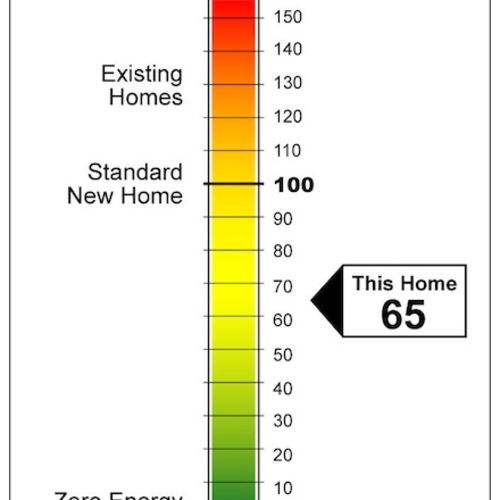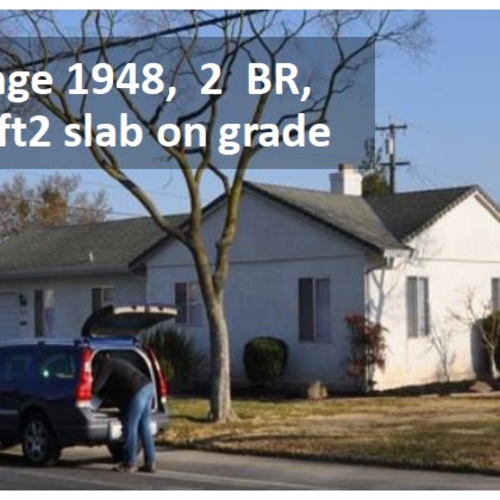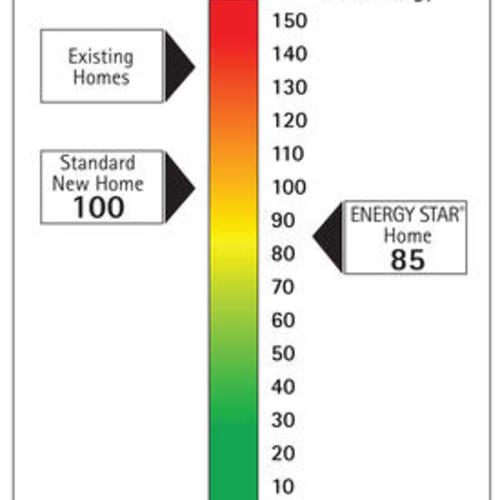
Image Credit: RESNET
Anyone involved with the Energy Star Homes program has probably heard of the HERS Index, a method of scoring the energy efficiency of a new or existing home. A Web page maintained by the state of Arkansas, for example, explains that the “EPA requires a house qualifying for Energy Star to be built with best practices, tight ducts, and at least 15% more energy efficient than code as shown by a HERS Index score of 85 or less as determined by a HERS Rater.”
Knowing that the HERS Index measures a home’s energy efficiency is a good starting point. But it’s useful to dive a little deeper, to understand how the Index is calculated and exactly what it measures.
Defining the HERS Index
The HERS (Home Energy Rating System) Index was established in 2006 by the Residential Energy Services Network (RESNET), a California-based national association of home energy raters and energy-efficiency mortgage lenders. The lower a home’s HERS Index, the more efficient the home.
To calculate a home’s HERS Index, a rater uses a computer program — most commonly, REM/Rate. (RESNET has also approved three other software programs for calculating the HERS Index.) After the rater has entered data about the home into the program, REM/Rate compares the home being rated to a “reference home.” The reference home is an imaginary home of the same size and shape as the home being rated. In other words, the size of the reference house is not fixed; when a house is being rated, it is always compared to a reference house of the same size as the rated house.
The reference home does not have the same window area or window orientation as the home being rated; instead, the area of the windows in the reference home is assumed to…
Weekly Newsletter
Get building science and energy efficiency advice, plus special offers, in your inbox.

This article is only available to GBA Prime Members
Sign up for a free trial and get instant access to this article as well as GBA’s complete library of premium articles and construction details.
Start Free TrialAlready a member? Log in















28 Comments
Reference Home Windows
Martin,
The Reference home "shell" may have the same size, perimeter and surface area as the home being rated.
It does not have the same window area or window orientation as the home being rated.
I believe the reference home has 18% window to floor area and the windows are evenly distributed in orientation.
An easy way to improve the HERS index is to design less than 18% window area and to carefully orient and shade the windows.
AND... your design will consume less energy
Bailes' Misunderstanding
Allison Bailes' conclusion that the EPA Home Energy Yardstick "ignores the physical characteristics of a house and looks only at the effects of occupant behavior" perpetuates a misunderstanding of the Yardstick. The Yardstick most certainly does reflect the physical characteristics of a house: if I add insulation to my house while keeping my behavior the same, the Yardstick score will get better. The important point is that the Yardstick reflects both physical characteristics and behavioral choices, whereas the HERS score holds the behavioral choices constant, or at least tries to.
A more important difference between the EPA Yardstick and the HERS score is that the former measures actual energy usage, while the latter is based on predicted energy usage from an engineering model of the building. But that prediction is only as good as the energy model and, as Fairey and Goldstein note, the HERS energy model is not well calibrated to actual energy usage.
David Fay
EnergyMetrics
Wall and Roof Orientation
I have recently started playing with REM/Design (very similar to REM/Rate...one of the software models used with the HERS Index)
The software does account for window orientation and window shading...
But as far as I can tell it does NOT consider the orientation or shading of the Walls or the Roof planes.
I think the REM/Design software does seem to be very useful... but not perfect
Maybe it will be a good tool for designing the HalfassiveHaus
perhaps REM/Design can be used as the HHPP(HalfassiveHausPlanningPackage)
Response to John Brooks
John,
Thanks very much for correcting my misunderstanding about the window area and window orientations in the reference home. I have edited the text of the blog to reflect your correction.
Version 3
It looks like ES version 3 is changing the glazing parameters for the reference home
http://www.energystar.gov/ia/partners/bldrs_lenders_raters/downloads/V3HERS_IndexTargetProcedure.pdf
Not the Same Shape and Orientation
The Reference home may have the same surface area and perimeter as the home being rated...
It does not have the same shape and orientation
Another response to John Brooks
John,
I just got off the phone with Philip Fairey. We discussed the question of whether the reference home and the rated home have the same shape and orientation. The short answer is that they do.
The long answer is, "It's complicated." Not all RESNET-approved software programs use the same energy modeling engines to calculate the HERS Index. Differences in these energy modeling engines sometimes require different approaches to modeling.
Some models allow the reference home to have windows that face a different orientation than the walls in which the windows are set; other models do not. For the models that allow the reference home to have windows facing a different orientation than the walls -- a situation described by Phil Fairey as "models which don't require the building to close from a geometrical perspective" -- the windows are abstract mathematical constructs rather than windows that sit in a wall. The wall may face southeast, and be modeled as a southeast wall, but the window is assumed to face south -- without any explanation of how that is geometrically possible. It's a mathematical equation -- it's not a real house.
Other models will occasionally change the orientation of the reference home (but not the rated home) by 45 degrees or some other rotational amount in order to force the windows to face the true cardinal points.
Most RESNET-approved software programs allow but do not require raters to enter all of the data required to be sure that the reference house is the same shape as the rated house. Raters in a hurry sometimes simplify the house shape to simplify the data entry -- an approach which is evidently allowed.
HERS Change
Early on the HERS best score was 100 (lowest energy use), then the rating system was inverted so a 0 is the goal for efficiency. I believe this came about with the introduction of the Zero Net Energy concept.
The limited nature of compliance tools
When I used to build a lot of energy models in REM/Design for retrofit analysis, I quickly learned the tricks of fast data entry. All above grade walls are entered as a single input. The analysis does not change at all when the walls are broken up into their actual proportions, because, as someone else mentioned, there are no orientation or shading inputs for the walls. If you want to apportion heat loss or heating/cooling energy use to a given wall, just calculate its proportion of total wall area. The calculations/simulations in REM/Design are not very detailed from what I can tell, nor are they dynamic. I don't believe it is an hourly simulation model, which means it is using some sort of degree-day bin analysis to pump out an annual energy use number, based upon numerous simplifications. You are not even provided, say a monthly energy use description, which would provide a little bit of useful info. Equipment sizing and design loads I'm sure are just based on ASHRAE 98.5% conditions. Unfortunately, none of this helps a building designer to understand the integrative, dynamic impacts of the decisions they make. You don't know what the temperature is doing in a given room with specific orientation, adjacencies, internal loads ,etc. This is the crux of the problem, REM/Design is not a design tool, it's just a compliance tool. Those looking for nuanced answers to complex problems will be befuddled.
A somewhat better option, I believe, is Energy Gauge by FSEC. Energy Gauge at least does hourly simulation using a DOE2 back end, which means that it is running through legitimate weather files, and has the ability to give hourly outputs for energy, temperature, etc. These features can make it more useful, while stil performing HERS score analysis. Sill other simulation tools are more useful, but do not provide HERS analysis. Of course, from what I can tell, none of these programs have reasonable models for natural ventilation/infiltration, which makes them next to worthless for analyzing dynamic ventilation options.
A question for Brennan Less
Brennan,
You wrote, "All above grade walls are entered as a single input." Are you saying that REM/Design can't distinguish between a long skinny house and a cube? Both houses are modeled the same?
Are you saying that the rater doesn't even enter individual inputs for the areas of the south elevation, the east elevation, the north elevation, and the west elevation?
Bailes's misunderstanding...or lack of coffee?
David Fay, you're absolutely right. I must have written that comment (nearly two years ago) before I'd had enough coffee to connect my writing with what I actually know. Of course the Yardstick takes into account the physical characteristics of the house. I really don't know how I could've written otherwise, even early in the morning.
Wall inputs
Martin, yes, that's correct that walls get entered without orientation and without any indication of the shape of the house. The only way a rater can affect that would be to change the framing factor for a particular wall type. Windows get orientations and are assigned to walls, but if a house has only one type of wall, there could be only one wall input, and it would look the same to REM if it were a cube or a long skinny box or a complicated mish-mash of shapes.
Response to Allison Bailes
Allison,
Thanks for your comment. To reflect your wiser, caffeinated view of the topic, I have edited the paragraph quoting you.
Another response to Allison
Allison,
My own shorthand term to describe a house that you refer to as "a complicated mishmash of shapes" -- what Jesse Thompson refers to as a house with "18 bay windows and dormers (chock full of difficult-to-air-seal, difficult-to-thermally-break and difficult-to-insulate construction transitions)" -- is a "crenellated house."
It is quite surprising that REM/Rate can't distinguish between a crenellated house and a cube. They certainly perform differently.
[Later edit: Actually, I see that REM/Rate does distinguish between a crenellated house and a cube, albeit crudely. REM/Rate knows that a crenellated house has more exterior surface area per square foot of indoor conditioned space than a cube, and therefore loses more heat on winter nights per square foot of indoor conditioned space than a cube. However, it seems as if REM/Rate doesn't account for the other problems associated with crenellation.]
I like it!
The crenelated house. That's a good one!
REM's lack of input detail may be surprising, but it's true. There's a lot of work going on in the energy modeling world now, so I imagine we'll see some improvements in the future.
Response to Kevin Dickson
Kevin,
I agree with you that actual energy use (measured in kWh, BTU, or dollars) is a much more useful measurement than HERS or any system (including Passivhaus) based on conditioned floor area. Area-based metrics allow large houses to be rated highly even if they use a lot of energy.
Good discussion on the blog page that you linked to. Thanks.
Excellent article, we can explain the variances if we try...
Martin did a great job, even for 5000 words, of explaining the HERS Index Rating. He is correct that actual energy use can be all over the map, in relation to the HERS Index Rating. Those variances can usually be explained in relatively mathematical terms, if you look closely at the occupant loads and habits. They can be quantified, and will usually show that the estimated energy use predicted by the RemRate (or similar) program will be pretty accurate.
I recently ran numbers for our below-net-zero-energy home at the Painted Hills unit of the John Day Fossil Beds National Monument at Mitchell, Oregon. This is a Ranger Cabin at a National Park, and it is occupied by one person. The HERS score was -15, indicating that the house should produce 15% more energy over and above its usage than what a house built to the 2006 IECC would use. By subtracting the predicted energy use from the predicted energy generated by the PV, I calculated how much was surplus. That surplus would represent 15% of the usage of the 2006 IECC model house. I used that number to calculate the energy use predicted for the Code house, and from there I could generate a lot of other useful data. One thing I was able to calculate is what the HERS score would have been without the PV installed (yes, I could have just asked the HERS rater to provide that, but I just love crunching numbers..) Then I used the actual electricity production and actual usage numbers from the first four months of operation of the house to generate some interesting numbers.
Some things we learned:
1. The house would rate HERS 43 without PV, but is operating as if it were a HERS 27.
2. The house is rated HERS -15, but is operating as if it were a HERS -41.
On the surface, it looks like the HERS rating is really screwed up, but not so fast! The house is only being occupied by one person, and that person is not home at all during the day, except on weekends. The assumptions in the RemRate program would have this home occupied by at least two persons, and that would double the amount of laundry, showers, cooking, and many other functions of living. If we look at the difference in the HERS ratings without PV, and compare the predicted energy use for the occupant load related items, it is easy to see that for this home, each occupant would use the energy equivalent of HERS 16, and the envelope (for heating and cooling) would use HERS 11. Subtract 16 from the predicted 43, because there is only one occupant instead of two, and this house is performing exactly as designed.
Regarding the extra surplus energy generated, remember that approximately HERS 16 of that surplus is because there is only one occupant. I believe the rest (HERS 10 worth) is because the solar panels have been producing more energy during the cool spring months of the year, and that generating capacity may actually decrease during the summer. We are using February through May data at this point, so we need another eight months of data before reaching any final conclusions about the energy production. It is common to have year over year differences in production of more than 20% for PV systems on the same house simply due to weather variations.
In conclusion, I think the best way to do actual energy-use comparisons is to relate them to the HERS prediction, then use measurable occupant behavior to explain the difference. This can be done in a totally objective manner, and delivers repeatable results.
"It's Too Complicated"
Let's see, it takes Martin Holladay, one of the best explainers in this industry, 5000 words to explain HERS ratings. I'm just a small local homebuilder. How the in the heck could I ever hope to explain it to a homebuyer?
Since I want to build homes and not spend time explaining a rating system to customers that haven't taken the coursework needed to understand HERS, I will just reject HERS and LEED -H..
I can imagine a performance-based rating system based on actual home energy usage and temperature data. A rating cannot be made on an unbuilt house, so it favors builders that have actually built some homes and taken data. It would be a simple dollars per year figure like an EPA rating for appliances.
A custom home's unbuilt rating would have to be interpolated from other similar homes by that builder.
More details at http://greenbuildingindenver.blogspot.com/2010/10/leed-for-homes-rating-system.html
Crenellation
"Crenellation - a rampart built around the top of a castle with regular gaps for firing arrows or guns".... "A pattern along the top of a parapet (fortified wall), most often in the form of multiple, regular, rectangular spaces in the top of the wall, through which arrows or other weaponry may be shot, especially as used in medieval European architecture." So not a general word for architectural doodads, and only indirectly affecting energy use - parapet walls are prone to leaky flashings and generally more trouble than they're worth if you're not inclined to get into bow-and-arrow fights with the neighbors. I agree it would be useful to have a word for arbitrary complications of building forms that negatively affect their energy performance - name the beast in order to tame it. This one doesn't quite fit the bill though. Wish I had a better suggestion. Anyone?
Response to James Morgan
James,
You're being too literal, James. It's a poetic leap -- an attempt to sum up a concept in a single word.
(I can assure you that I know what crenellation is.)
I'm always open to the suggestions of my fellow poets and word-coiners, however. Invent away.
Pustulated
might hit the metaphorical spot a little nearer. Indicates an eruption of the primary enclosure, conveys a nicely opinionated sense of undesirable and ugly, no possibility of confusion with the primary meaning.
On the related topic: I'd like to suggest that not all dormers and bays are bad, if that's implied. I'm very familiar with the excess of these features in many spec plans, however I've found they can be useful additions to the architectural palate when used sparingly. The energy penalty need not be great when executed properly, in fact can often be less than adding additional square footage to achieve the same functionality. Example: a bay window we added to a room to be used as yoga studio provides needed occasional storage for students' belongings as well as esthetic enhancement. The alternative would have been to extend the full width of the room for two feet, not only at the studio level but also in the bedroom suite below. I should probably add that we do not glaze the sides of the bay when we project a window like this, and the light reflectance offered by the deep flank walls is glorious.
Obviously architectural complications like this make the HERS analysis even harder. We try to make our homes easy to build well but would never sacrifice lifelong functionality for constructional convenience. Similarly I'd hate to design a home based on how easy it is to calculate some abstraction of relative energy performance.
Vocabulary proposals
James,
"Pustulated" will work. I like it.
Or one could go further -- how about "bubonic"? That is, covered with buboes.
If I'm in a fulminating mood, I can combine them all -- "This crenellated, pustulated, bubonic monster is an energy disaster!"
More on REM and other modeling
Allison, thanks for dropping in and adding to my post, responding to Martin's questions about modeling surfaces/walls in REM. Martin, it should not be surprising that these tools don't account for all of the real world interactions of a crenelated home. They are simplified engineering models, which work best under steady-state conditions, in those situations where the building most directly reflects the underlying logic of the model itself. I think that this is why thermal performance in highly-insulated homes conforms well with modeling efforts, because the actual assemblies perform much more like the engineering model assumes they do. I would guess that REM assigns some boiler plate aspect ratio to the wall area that is entered, and performs some sort of weighted analysis to attempt to account solar insolation effects...maybe that's wishful thinking. Of course if the whole purpose of the tool is the production of an asset rating, which is a comparison to a baseline home that doesn't have the same orientation as the real home, then who really cares about the orientation of the individual walls...accuracy, to some extent, has already been thrown out the window. Again, this is why I prefer other modeling tools, whose sole purpose is not the production of an asset rating.
HERS is a moving target!
Note that the same exact home rated in 2006 will have a different score in 2012. What?
If you have a hard time grokking that, then just take it to a logical end point:
Eventually the IRC code may require all homes to be zero net energy cost. At that point the reference home will have a HERS score of 100 and Zero at the same time. Then you will have one worthless standard rating system.
Response to Kevin Dickson
Kevin,
Your statement, "the same exact home rated in 2006 will have a different score in 2012," is not correct for most homes. The only adjustment to the HERS Index since 2006 was a recent minor tweaking of the budget for appliances and miscellaneous energy use for large homes. Most homes still score the same as when the HERS Index was first introduced in 2006.
Do you have special information about an impending change in 2012? If a major change is in the offing, that would be a surprise to me and Philip Fairey.
Note that changes to the IECC and IRC do not affect the HERS Index, since the HERS Index remains anchored by the 2006 International Energy Conservation Code. There is no automatic mechanism that changes HERS Index calculations as the IECC changes -- nor is there any political movement to make that happen.
Energy Star
Martin,
Thanks for setting me straight. Energy Star is tied to the IECC/IRC, and changes as the code changes. Then I made an incorrect leap to HERS. Is LEED-H anchored to 2006?
Second response to Kevin Dickson
Kevin,
As far as I know, the energy points awarded under the LEED for Homes program are tied to a home's HERS Index. Of course, nothing prevents the USGBC from changing the energy requirements or scoring system used in LEED for Homes in the future.
Who came up with this?
HERS does not make sense to me.
1) Why give a number with no unit, if it must (or should) be based on physics and calculates energy usage (kWh).
2) Houses with nicely orientated windows do get a benefit, good shapes do not.
Obviously it is hard to predict the real energy consumption with any software because it is so dependent on occupants behavior. My only explanation why someone came up with the HERS system is that they were afraid of getting sued. Anyway my opinion is: Use kWh/ (SF a) and have a penalty if the ratio SF/Person is high. I also hope to see a Net-Zero movement. We know its possible and the up charge is not as much as most people think.
Log in or become a member to post a comment.
Sign up Log in